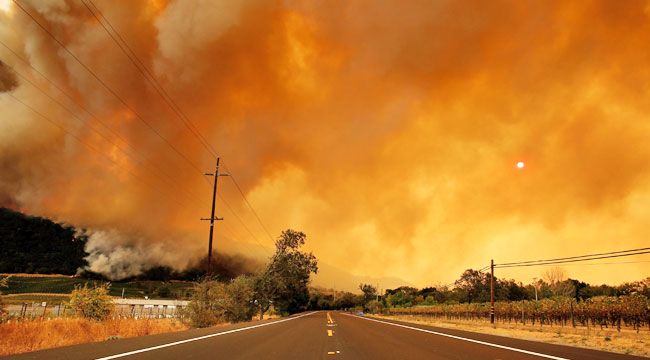
Since late Sunday night, fast-moving wildfires have raged through Northern California and have brought death and destruction that are both bound to grow worse. Napa, Sonoma, and Yuba counties have now burned for over 24 hours, and a massive brush fire also took over Orange County’s Anaheim Hills, where smoke filled the sky and ash rained down on Disneyland.
The statistics associated with these blazes are already sobering. The New York Times currently reports that at least 10 people have died as a result of these infernos. More than 100 more have been hospitalized from burns, smoke inhalation, and other related conditions. Further, the fires have leveled at least 1,500 structures (both residential and commercial), and over 20,000 residents have evacuated their homes.
Thus far, CNN reports that at least 57,000 acres have been torched in these fires. Napa and Sonoma counties have sustained the most damage, and the City of Santa Rosa has been particularly hard hit with strong winds fueling the uncontrollable conditions, according to the Weather Channel:
In Santa Rosa, in Sonoma County, thousands were forced to flee in the early morning hours. Senior living facilities and hospitals, including 200 people from a Kaiser Permanente Hospital on Bicentennial Drive and Sutter Hospital, were evacuated, The Santa Rosa Press Democrat reports.
“Imagine a wind-whipped fire burning at explosive rates,” California Department of Forestry and Fire Protection Director Ken Pimlott told AP. “This is 50 miles per hour. Literally, it’s burning into the city of Santa Rosa … burning box stores.”
Governor Jerry Brown has issued state of emergency proclamations for all affected counties, and the fires are only growing more aggressive as time passes. As of now, all of the fires are considered to be uncontained and will obviously continue to burn for days (or weeks) to come. At this stage, fire crews can’t get even begin to make progress on the blazes, and Cal Fire Battalion Chief Marshall Tuberville has even stated, “This is an example of nature in control, and we are doing what we can, but we’re not being that effective at stopping the fire.”
(Via Weather Channel, New York Times, CNN & Washington Post)
